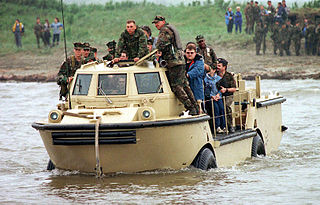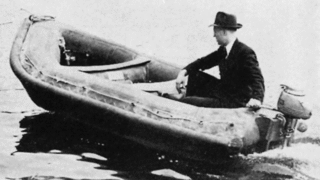
An amphibious vehicle, is a vehicle that is a means of transport viable on land as well as on or under water. Amphibious vehicles include amphibious bicycles, ATVs, cars, buses, trucks, railway vehicles, combat vehicles and hovercraft.

An inflatable boat is a lightweight boat constructed with its sides and bow made of flexible tubes containing pressurised gas. For smaller boats, the floor and hull is often flexible, while for boats longer than 3 metres (9.8 ft), the floor typically consists of three to five rigid plywood or aluminium sheets fixed between the tubes, but not joined rigidly together. Often the transom is rigid, providing a location and structure for mounting an outboard motor.

Landing craft are small and medium seagoing watercraft, such as boats and barges, used to convey a landing force from the sea to the shore during an amphibious assault. The term excludes landing ships, which are larger. Production of landing craft peaked during World War II, with a significant number of different designs produced in large quantities by the United Kingdom and United States.

The Zodiac Milpro Futura Commando 470 or in short FC470 Combat Rubber Raiding Craft (CRRC), also known as the "Combat Rubber Reconnaissance Craft," is a specially fabricated rubber inflatable boat often used by the U.S. Navy, U.S. Marine Corps, the U.S. Army, and others. The CRRC is typically called "Zodiac," referring to the boat's manufacturer, Zodiac Milpro.

Amphibious warfare is a type of offensive military operation that today uses naval ships to project ground and air power onto a hostile or potentially hostile shore at a designated landing beach. Through history the operations were conducted using ship's boats as the primary method of delivering troops to shore. Since the Gallipoli Campaign, specialised watercraft were increasingly designed for landing troops, material and vehicles, including by landing craft and for insertion of commandos, by fast patrol boats, zodiacs and from mini-submersibles. The term amphibious first emerged in the United Kingdom and the United States during the 1930s with introduction of vehicles such as Vickers-Carden-Loyd Light Amphibious Tank or the Landing Vehicle Tracked.

The landing craft, tank (LCT) was an amphibious assault craft for landing tanks on beachheads. They were initially developed by the Royal Navy and later by the United States Navy during World War II in a series of versions. Initially known as the "tank landing craft" (TLC) by the British, they later adopted the U.S. nomenclature "landing craft, tank" (LCT). The United States continued to build LCTs post-war, and used them under different designations in the Korean and Vietnam Wars.

The Amphibious Vehicle, Tracked (LVT) is an amphibious warfare vehicle and amphibious landing craft, introduced by the United States Navy and United States Marine Corps. The United States Army, Canadian Army and British Army used several LVT models during World War II, and referred to those vehicles as "Landing Vehicle, Tracked."

The landing craft, vehicle, personnel (LCVP) or Higgins boat was a landing craft used extensively by the Allied forces in amphibious landings in World War II. Typically constructed from plywood, this shallow-draft, barge-like boat could ferry a roughly platoon-sized complement of 36 men to shore at 9 knots (17 km/h). Men generally entered the boat by climbing down a cargo net hung from the side of their troop transport; they exited by charging down the boat's lowered bow ramp.

DD or Duplex Drive tanks, nicknamed "Donald Duck tanks", were a type of amphibious swimming tank developed by the British during the Second World War. The phrase is mostly used for the Duplex Drive variant of the M4 Sherman medium tank, that was used by the Western Allies during and after the Normandy Landings in June 1944.

A Landing Craft Utility (LCU) is a type of boat used by amphibious forces to transport equipment and troops to the shore. They are capable of transporting tracked or wheeled vehicles and troops from amphibious assault ships to beachheads or piers.

The Landing Craft, Support (Large) were two distinct classes of amphibious warfare vessels were used by the United States Navy (USN) in the Pacific and the Royal Navy in World War II. The USN versions which were later reclassified Landing Ship Support, Large also performed radar picket duty and fire fighting.

The LCRS was a small inflatable boat which was used by the United States Navy and USMC from 1938 to 1945. During World War II 8,150 LCRSs were made. It had a weight of 95 kg and could transport seven men. With no armor, LCRL were often used at night for Amphibious warfare. Most were built by the Goodyear Tire and Rubber Company.

An amphibious warfare ship is an amphibious vehicle warship employed to land and support ground forces, such as marines, on enemy territory during an amphibious assault.
The Fleet Landing Exercises, or FLEX were amphibious landing exercises conducted by the United States Navy and United States Marine Corps between 1935 and 1941. The purpose of these exercises was to formulate a workable amphibious warfare doctrine. The development of the necessary craft and other equipment, and the proper tactical deployment of them were also results. Finally, the exercises demonstrated the usefulness of a standing body of Marines, the Fleet Marine Force, specially prepared for amphibious expeditions.
The Observer Group was a joint-United States Army/Marine Corps unit that was the first in the United States and Fleet Marine Force to be organized and trained specifically for amphibious reconnaissance. The Observer Group experimented in the methodology and equipment for projecting reconnaissance from the sea before the establishment of the OSS Maritime Unit, the Underwater Demolition Teams, and before the Army Special Forces and Air Commandos. It was also the birth of naval amphibious intelligence.

The Inflatable Raiding Craft (IRC) is a series of fast raiding and assault craft in service with the Royal Navy (incl. the Royal Marines and the Special Boat Service). Despite being among the smallest of the amphibious craft, the IRC is one of the most widely used due to its mobility and versatility. The IRC is essentially a type of inflatable boat, the American equivalent is the Combat Rubber Raiding Craft.

Splinter fleet or Splinter navy was a nickname given to the United States wooden boats used in World War II. The boats served in many different roles during the war. These boats were built in small boatyards on the West coast and East coast, Great Lakes and the Gulf of Mexico. They could be built quickly, in just 60 to 120 days. Most of the boats were built by boatyards that already had the tools and knowledge from building yachts, sailboats and motor boats. Many were built by craftsmen in family-owned small businesses. Under the Emergency Shipbuilding Program and War Shipping Administration contracts went out to over fifty boatyards across the country. The boats were built for the US Navy, the United States Army Air Forces, United States Coast Guard, and US Army. Some of the wooden boats went to Allied nations on the Lend-Lease program.















